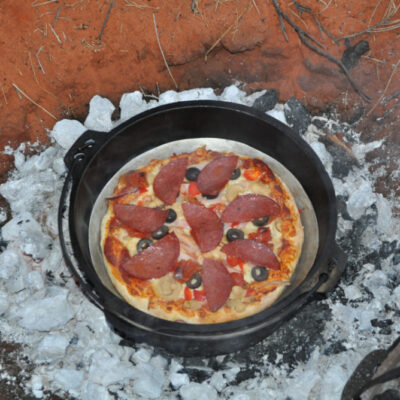
Gluten-Free Neapolitan Pizza
Speed - 96%
Simplicity - 96%
Tastiness - 98%
97%
Yummy!
The crust did end up looking and feeling short of a more traditional Neapolitan. It did have a very similar flavor though. Delicious!

Ingredients
For the Dough
- 2.5 Cups Gluten-Free All-Purpose Flour
- 2 Teaspoons Xanthan Gum
- 1 Teaspoon Salt
- 1/4 Cup olive oil
- 2 Teaspoons Active Dry Yeast
- 2 Teaspoons Sugar
- 3/4 Cup Warm Water
For the Filling
- 1.5 Cups Mozzarella Cheese
- 3 Pieces Tomatoes sliced
- 1.5 Cups Pizza Sauce
Instructions
- Combine yeast, sugar, and water in a bowl. Leave to bloom for 10 minutes.
- Combine the gluten-free flour, xanthan gum, and salt in a bowl.
- Add the olive oil and active yeast mixture into the dry ingredients.
- Knead the dough on a lightly floured surface.
- Set the dough to rise in a lightly oiled bowl. Leave for an hour.
- Press the dough onto a pizza pan.
- Pre-bake the dough for 5 minutes at 425 F.
- Toast the edges of the crust with a kitchen torch.
- Top the pizza.
- Bake for 10 minutes at 425F.
I am fully aware that I’m up for a challenge recreating a classic Neapolitan pizza using gluten-free flour alternatives. Honestly, this recipe does have a few shortcomings. Still, I do believe that it’s the closest I could get to a Neapolitan given the limitations.
A Neapolitan crust, as we all know, is significantly puffed up with all those giant air pockets inside. Well, beginning with some yeast will get us somewhere near that.

Let’s mix up some salt and xanthan gum into a blend of gluten-free all-purpose flour. That gum will help get our dough elastic and a bit chewy in the end.
There are a lot of alternatives to xanthan if for some reason you wish to go gum-free. Flax meal, gelatin, agar-agar, to name a few.

Stir the active yeast mixture into the dry ingredients until everything comes together.


Then, set the dough onto a lightly floured surface and knead just until it comes into a smooth ball.

Give your dough about an hour to rise in a lightly-oiled bowl.

Flatten the dough with a rolling pin using a round pan as a guide.

Notice how deeply charred that crust on a traditional Neapolitan is? That’s a result of baking with a wood-fired oven at extremely high temperatures.
Not having access to such oven, I tried getting a similar char with my kitchen torch.

The toppings then go on top. Tomatoes and mozzarella – at least we’ve got this part almost authentic. I say almost because a die-hard Neapolitan recreation of this pizza would require the use of San Marzano tomatoes, a variety that grows somewhere in the vicinity of Mt. Vesuvius.
I tried baking this pizza at the highest setting my oven could go up to. That’s just how a traditional Neapolitan is done.






Ingredients
For the Dough
- 2.5 Cups Gluten-Free All-Purpose Flour
- 2 Teaspoons Xanthan Gum
- 1 Teaspoon Salt
- 1/4 Cup olive oil
- 2 Teaspoons Active Dry Yeast
- 2 Teaspoons Sugar
- 3/4 Cup Warm Water
For the Filling
- 1.5 Cups Mozzarella Cheese
- 3 Pieces Tomatoes sliced
- 1.5 Cups Pizza Sauce
Instructions
- Combine yeast, sugar, and water in a bowl. Leave to bloom for 10 minutes.
- Combine the gluten-free flour, xanthan gum, and salt in a bowl.
- Add the olive oil and active yeast mixture into the dry ingredients.
- Knead the dough on a lightly floured surface.
- Set the dough to rise in a lightly oiled bowl. Leave for an hour.
- Press the dough onto a pizza pan.
- Pre-bake the dough for 5 minutes at 425 F.
- Toast the edges of the crust with a kitchen torch.
- Top the pizza.
- Bake for 10 minutes at 425F.
Neapolitan Pizza
Also called pizza Napoletana this style of pizza originally came from Naples, Italy – although it is now fairly popular in the United States and in other parts of the world. One of the key components of the pizza style is its simplicity.
In particular, it uses as basic dough, along with just a few simple toppings. Traditionally, those toppings are fresh mozzarella cheese and basil, along with raw tomatoes and olive oil.
Get Gluten Free All Purpose Flour on Amazon!
At the same time, the pizza traditionally is heavier in sauce than in cheese, which is often the reverse of American pizza approaches. The emphasis on sauce often means that the pizza may get soggy in the middle. For that matter, you often won’t even be able to eat a Neapolitan pizza by hand. Instead, you’d be forced to use a knife and fork.
Finally, these pizzas do tend to be on the small size. So, they’re more in line with a personal pizza, rather than a large one to share.
None of these aspects are disadvantages though.
The simple nature of the ingredients allows the flavors to shine. Plus, they result in a unique experience overall and can be fun to make at home. You can actually mimic the effect of a wood-fired Neapolitan pizza oven in your backyard. One way is with a gas grill insert from KettlePizza, and the other is with a Weber charcoal grill insert from the same company. They are a whole lot of fun for me personally, and I can imagine that they would be awesome to use in a family with kids or with friends at your next bbq get-together.
Of course, the Neapolitan pizza in this recipe doesn’t meet all of those characteristics. Gluten-free pizza making does have its limitations, and there are also some approaches that are relatively difficult to achieve at home. Still, the end result is fairly close and would be more than enough to satisfy most pizza lovers.










 Gluten-Free Calzone Recipe
Gluten-Free Calzone Recipe
Leave a Reply